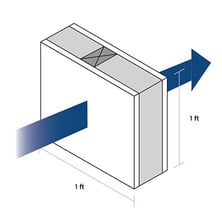When it comes to energy costs, we all know the big numbers lie in heating and cooling the house. A large portion of this excessive energy use is due to air leakage as well as too little – or improperly installed – insulation. A good thermal boundary, which includes insulation, windows and doors, not only reduces energy waste, but also greatly increases an occupant’s comfort. Which brings us to heat flow. How heat flows, where it goes and how to control it is key to a whole-house systems approach that can create better homes for today’s homeowners.
The Basics of Heat Flow
Heat moves in a home in three ways:
- Conduction: When two surfaces at different temperatures are in direct contact, heat will flow from the warmer materials to the cooler ones until a balance is reached.
- Convection: When warm air naturally rises within a space and colder air falls.
- Radiation: All objects radiate heat. This heat can travel across an open space and be absorbed by cooler objects.
U-Factor and R-Value Defined
How quick heat flows through a material is called the material’s U-Factor. The ability of a material to resist heat flow is its R-Value. R-Value measures the effect of conduction, convection and radiation. The higher the R-Value, the slower the heat flow through the material.
The Impact of Heat Flow
Heat flow can affect building occupants as well as a building’s durability.
- For Occupants: Improper heat flow can result in localized cold spots. This not only affects people’s comfort, it can spawn mold and mildew when moisture-laden air comes in contact with cold surfaces. Condensation can also be a problem.
- For Buildings: Water vapor in a building will automatically move from a warm, dry area to a cold, moist one. This can cause condensation, which can occur inside walls and other structures, making wood rot and mold form. Even unintended heat flow – say from solar radiation – can have a negative impact on a building’s durability by driving moisture-rich air into structural members both inside and outside the building.
Preventing Heat Flow With Insulation
Insulation is used to prevent heat from passing through building walls, ceilings and floors. It slows heat transfer by trapping pockets of air. According to Building Science Corporation’s Thermal Metric Report,[1] all insulation types perform essentially the same as long as they are properly air sealed and installed.
Insulation Problems
When insulation is improperly installed or air is allowed to pass through it, the thermal barrier is broken. The resulting heat loss or gain can greatly reduce energy efficiency.
Here are five ways this can happen:
- Voids within the insulation
- Gaps between the insulation and the adjacent framing members
- Convection of airflow within improperly insulated assemblies
- Air leakage bypassing the thermal boundary
- Highly compressed insulation
Want to insulate yourself from unsatisfied customers? Managing heat flow is one of the best ways to do it. A good thermal boundary not only reduces energy waste, it greatly increases a client’s comfort.
Want more specifics about managing moisture, heat and air flow in homes? Download our Building Science 101 guide now for more information and suggested solutions.
[1] http://www.insulationinstitute.org/wp-content/uploads/2015/12/Thermal_Metrics_Project_Report.pdf





